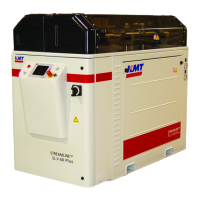Section 9
High Pressure Water System
20412997
8-2012/Rev 12
9-19
7/8” Diameter Plunger 1-1/8” Diameter Plunger
There are two holes in the sealing
head. The dowel pin on the poppet
retainer is positioned in one and the
inlet poppet is positioned over the
other. Ensure that the inlet poppet is
positioned over the through hole in
the sealing head.
4. Spray Loctite 7649 on the threads of the
retainer screws and allow to dry. Apply
one drop of Loctite 242 on the threads
only. Do not get any Loctite on the
poppet or any other surfaces on the inlet
check valve.
4. Spray Loctite 7649 on the threads of the
retainer screw and allow to dry. Apply
one drop of Loctite 242 on the threads
only. Do not get any Loctite on the
poppet or any other surfaces on the inlet
check valve.
5. Use the T20 star drive to tighten the
poppet retainer screws and torque to the
torque specifications in Table 9-1.
5. Use the wrench or socket to tighten the
poppet retainer screw. Tighten the poppet
retainer screw to the torque specifications
in Table 9-1.
6 Inspect the assembled unit to ensure the
poppet moves freely and the poppet
retainer screws are seated.
6. Inspect the assembled unit to ensure the
poppet moves freely and the poppet
retainer screw is seated.
Sealing Head Maintenance
The sealing head should be inspected for scratches, excessive sealing damage or erosion marking
on the cone ring contact surface, and on the inlet poppet valve contact surface. If defects are
detected, the surfaces must be refinished. The sealing head can be returned to KMT Waterjet for
refinishing.
1. Clean the surface on the cone ring with 600-grit wet/dry sandpaper, using a radial motion.
It will not be possible to fully remove the main sealing marks.
2. Inspect the inlet poppet valve sealing surface for pits, scratches or jetting erosion. If
necessary, refinish the surface.
Place a piece of 1/4-1/2” thick plate glass, not window glass, on a sturdy table to provide
an absolutely flat surface. Place a piece of 400-grit wet/dry sandpaper on the glass. Use
even, deliberate strokes, rotating the sealing head approximately 10-15 degrees after each
stroke. Polish the sealing head until it is flat and smooth. Be careful not to cause
additional damage by tilting or tipping the part while polishing.
3. When the sealing head is flat and smooth, perform a final polish with 600-grit wet/dry
sandpaper.

